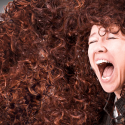The moon has been our friendly neighbour in the sky for billions of years. It has guided us home, kept us on time, protected us, propelled us into space and has even launched dance crazes!
It’s hard to fathom what we’d do without it. But for the sake of science, let’s try to envision a moonless world.
What would happen to Earth? Would humans still exist? What would life be like?
So how, exactly, did we get a moon in the first place? Scientists believe it started off with a splash. The Giant Impact hypothesis, also known as The Big Splash, theorizes that a Mars-sized celestial object named Theia came crashing into Earth 4.5 billion years ago, tossing vaporized particles of Earth’s crust into space.
At this point, Earth was still a baby (baby sound), only 30-50 million years old, and not much more than molten lava. Some scientists call this early Earth, Gaia. Over time, the debris of Gaia and Theia joined together in a dance with Earth’s gravity, and formed the Moon we know and love today.
Lucky for us, our Moon’s orbit and gravitational pull tilt the Earth 23.4 degrees, creating tidal bulges that help slow the rotation of our planet just enough for life to safely exist – or so we think. Despite a popular theory, having a moon is no longer a requirement for life to exist.
So could we really exist without our Moon? How would we survive?
With a little gravitational help from our friends, the Sun and Jupiter, life still could have evolved without a moon. But how?
With no Moon to keep the Earth on an even keel, things might get a little wobbly. We would have to put up with some extreme weather, our concept of time and seasons would drastically change, and we may evolve to look short and stubby. There is, however, another hypothesis.
In a study conducted at the NASA Ames Research Center in 2011, scientists performed complex simulations in which Earth didn’t have its Moon, and measured the effects on Earth’s spin over time. The results were shocking.
They discovered that the Earth’s wobble would eventually stabilize, due to Jupiter’s immense gravitational pull, deviating no more than 10 degrees off its axis. Thanks, Jupiter!
Scientists have also found that the Earth might have spun backwards before the Moon formed. This would mean that the Sun would rise in the west and set in the east. Feeling dizzy yet?
Our sky would be a lot darker than usual without our Moon to reflect the light of the Sun. But that would be perfect for stargazing! Mind you, we’d still have a little bit of light from Venus to help light our way in the dark, but the Moon is 2,000 times brighter.
At the very least, we wouldn’t have to put up with wolves keeping us awake at night (howling sound). Farmers would have to be careful with their crops without a Harvest moon, and women’s menstrual cycles would change.
Despite these conditions, there’s a lot more to our Moon than just pure science. Without it, our whole idea of the Universe could change dramatically, slowing our progress as a species.
If it weren’t for Italian astronomer Galileo’s discovery of the Moon’s spherical shape in 1609, we’d probably still think that the Earth was the centre of the Universe, an idea proposed by Aristotle in 284 BCE that was widely accepted for over 1,500 years!
Our moon was instrumental in launching the Space Race, which propelled humans to the stars. In the words of Neil Armstrong, going to the Moon was “one small step for man, and one giant leap for mankind!” Without it, who knows if we’d even bother traveling to space?
Subscribe to What-If on YouTube or follow the show on Facebook Watch.
Sources
- “Did Neil Armstrong really say, ‘That’s one small step for a man’?”, KAREN KAPLAN, 2013.
- “Where did the Moon come from?”, starchild.gsfc.nasa.gov.




























Be the first to comment